Fire Risk Assessment for Heritage Structures of Lahore: Current Situation and Contributing Factors
Fire Risk Assessment for Heritage Structures of Lahore: Current Situation and Contributing Factors
Muhammad Rizwan Riaz1, Jawad Bashir Mustafvi2*, and Muhammad Shajee Ishtiaq1
1University of Engineering and Technology, Lahore, Pakistan
2University of Management and Technology, Lahore, Pakistan
*Corresponding Author: [email protected]
Abstract
Pakistan is recognized around the world for its heritage structures which represent the country&'s glorious history. These structures are of distinctive architectural and cultural importance. They differ from each other in various aspects of their ornamentations, building fabric, design, and construction process; however, they were typically built without any concern towards fire safety. Worryingly, mortifying accounts of fire disasters have been reported from all over the world. Fire incidents and fire disasters in heritage sites of the world amplify the fact that this threat should be fully recognized and precautionary measures must be taken beforehand. For this purpose, the technique used in this study is called Fire Risk Index (FRI). It has been used internationally for cities with historical values, especially in Portugal. In this study, this technique was applied to 12 cultural heritage buildings of Lahore. A site visit was conducted to each structure. Based on the observations and data, the value of FRI was derived for each structure. Furthermore, the characterization of the buildings was also carried out in terms of fire risk. It was found that Sheesh Mahal and Lahore Museum have the highest fire risk and were classified as high-risk buildings. Overall, the heritage structures included in this study comprised 17% high-risk buildings, 33% moderate-risk buildings, and 50% low-risk buildings. In the same vein, propagation of fire (P) was determined as the most prominent sub-factor in evaluating the FRI values, as there are 67% of heritage structures in which the contribution of this sub-factor is more as compared to other sub-factors. This study contributes towards the development of intervention packages as an efficient tool for fire risk mitigation purposes in heritage structures.
Keywords: contributing factors, fire risk, Fire Risk Index (FRI) method, heritage structures
Introduction
Heritage structures have great historical and architectural value (Garcia-Castillo et al., 2023). They also play an essential role in transmitting the culture from one generation to the next, as they assist the people of today to know more about the people of ancient times. The conservation of heritage structures is critical because it helps to maintain their presence and allows people to understand their significance and associated value (Shan et al., 2022). Most of the heritage structures are more than a century old and are vulnerable to damage from external conditions. These structures are often prone to both man-made and natural disasters, such as blast loads, floods, earthquakes, and fire. Among other causes of damage, fire disaster is the main cause of the deterioration of heritage structures (Neto & Ferreira, 2020).
Fire hazard is one of the major hurdles in achieving the conservation of heritage structures. The danger of fire is relatively higher in these structures due to their construction and material characteristics (Neto & Ferreira, 2020). In addition, they are susceptible to fire outbreaks due to factors such as their proximity to nearby buildings, the narrow width of streets around them that make it difficult for the fire emergency services to access them, the storage of combustible materials, and inadequate gas and electric installations (Neto & Ferreira, 2020). These structures were designed in ancient times when there were no fire standards that are used today. As a result, they typically do not satisfy the criteria set forth in existing fire standards (Garcia-Castillo et al., 2023). Therefore, a number of world-famous heritage structures and cities have been destroyed by fire throughout history including the Library of Alexandria (48 B.C.), the city of Rome (64 A.D.), St. Paul's Cathedral in London (1666), and the Cathedral of León (1966) (Venegas et al. 2020). Some other notable fire incidents of historic buildings are the 1992 fire incident at Windsor Castle in England (Garcia-Castillo et al., 2023), the 2018 fire incident at the National Museum of Brazil (which destroyed a 19th century building as well as nearly 90% of its preserve), and the 2019 fire incident at Notre Dame Cathedral in Paris, where the collapse of a more than 600-year-old timber-built spire occurred (Neto & Ferreira, 2020). In Pakistan, several heritage buildings have been damaged by fire including Radio Pakistan (The Express Tribune, 2023) and 500 years old Sheesh Mahal in DG Khan (The Express Tribune, 2016). It is to be noted that the loss of a heritage structure signifies not only the loss of a structure but also the loss of the works of art, furnishings, and cultural contents that are lost with it and cannot be recovered (Garcia-Castillo et al., 2023). Fire protection for such structures is thus receiving more attention these days.
The FRI method is a widely utilized approach to assess fire risk in heritage structures. Ferreira first utilized the FRI technique to assess fire hazards in Guimaraes, a historic Portuguese city (Granda & Ferreira, 2019). FRI method comprises two fundamental factors, namely the Global Risk Factor (GRF) and Global Efficiency Factor (GEF). GRF is composed of three main sub-factors that cover the fire initiation phase (I), the fire propagation phase (P), and the building evacuation phase (E). Whereas, GEF is composed of only one sub-factor, that is, the fire combat phase (C).
Numerous previous studies have stressed the application of the FRI approach to assess fire risk in heritage structures. Julia et al. (2021) conducted the assessment of fire risk generated as a result of earthquakes at historical places. They used the FRI approach in Leiria, Portugal to conduct an assessment of fire risk. Their study took into account the following factors: fire combat, fire propagation, and fire ignition. According to the results, the main contributing elements were fire propagation and ignition. It was discovered that 33% of the chosen buildings had a medium to high degree of fire risk as a result of the earthquake. Venegas et al. (2020) carried out an investigation regarding the occurrence of fires in historical structures present worldwide. The study was carried out during the period 1990-2019. It showed that the major contributing factors resulting in the occurrence of fire include vandalism, electrical circuits, and accidents. Indeed, vandalism was responsible for approximately 26% of fires. (Neto & Ferreira, 2020) conducted the assessment of fire risk and developed certain intervention packages to bring improvement in fire protection and prevention. The assessment of fire risk was performed by using the FRI method at the historical city of Guimaraes in Portugal. The results showed that the intervention packages were useful in decreasing the percentage of medium- to high-level fire risk structures from 67% to 1%, which costed 28.48 euros per square meter. Granda and Ferreira (2021) assessed the risk of fire in historical urban places using the FRI method. The study showed that the inefficiency of the evacuation paths and the inner characteristics of the structures and urban areas were the main contributing factors to the fire. Further, it was found that 67% of the selected structures had moderate to high levels of fire risk (Granda & Ferreira, 2021) also carried out fire risk assessment by utilizing the FRI method at the historical city of Quito, Ecuador. The study showed that the utilization of this method helped to identify the areas where fire risk is relatively greater. Moreover, it was found to be beneficial in deciding the priorities of investment for efficient risk mitigation.
Santos et al. (2017) carried out the evaluation of fire risk in historical areas. In their study, fire risk assessment was carried out by using GRETENER and ARICA methods in the historical city of Coimbra, Portugal. It was found that the ARICA method is more conservative as compared to the GRETENER method. (Ferreira et al., 2016) assessed fire risk in various regions of Sexial, Portugal by using the FRI method. They surveyed over 500 buildings for fire risk evaluation. It was found that electric and gas installations were the major contributing factors in causing the spread of fire. The results showed that the basic emergency planning requirement of fire could be fulfilled by integrating the fire risk results into a GIS platform which would be useful for fire risk mitigation. Santos et al. (2013) also utilized the FRI method for fire risk assessment in the historical city of Sexial, Portugal. Building typology cataloging was also carried out to support fire risk mitigation. It was found that high slopes of stairs, narrow openings of streets, and low accessibility of fire safety equipment were the major contributing factors in fire spread.
Fire safety regulations exist within the Fire Safety Provisions of the Building Code of Pakistan 2016. It outlines the importance of fire safety in buildings, emphasizing the significance of egress means, signage, fire doors, and building materials to prevent fire eruptions. However, there is a lack of quantifying fire risk prevailing in the heritage structures (Government of Pakistan, 2016). National Fire Protection Association (NFPA), Pakistan also provides fire safety codes and standards. In addition to complying with these regulations, Chapter 14-18 of Fire Safety Provisions stated that historic buildings must adhere to NFPA 914, while buildings storing or displaying cultural resources, such as museums or libraries, must comply with NFPA 909 (Government of Pakistan, 2016). Still, heritage buildings of Pakistan have no fire safety measures and do not follow any fire safety code.
In Pakistan, inadequate fire safety measures lead to numerous fires, causing deaths and economic loss. This study focuses on prevention, controlling fire spread and reducing severity, and structural fire safety. Data from three cities showed average daily fires, with commercial and residential buildings being most vulnerable. Compliance with codes is low, with fire design costing 3% of overall building costs (Shahid et al., 2014). Another research was carried out on fire-prone buildings of Karachi, Pakistan, revealing a lack of infrastructure and adequate training to deal with fire hazard. The Fire Brigade Department confirmed the issue. The study found negligence, violation of building codes, and lack of training as major causes of fire incidents (Rafi et al., 2012).
Pakistan has a large number of heritage structures present in different cities. Lahore is among the cities where there are numerous cultural heritage sites and historical places (Iftikhar, 2019). These heritage structures represent the culture and historical background of the nation. The Lahore Fort and Shalamar Garden are the two heritage structures present in Lahore, Pakistan which are also recognized as World Heritage Sites by UNESCO. However, there is no established method for fire risk evaluation and assessment in Pakistan. Moreover, there is a lack of awareness regarding fire risk assessment among the people. The evaluation of fire risk is of utmost importance to determine which intervention package(s) to use, as well as to assist the relevant institutes in making decisions regarding the priority of fire safety actions among the heritage structures.
By categorizing the structures into different risk categories using FRI, the study helps in prioritizing the sites that are more vulnerable and need immediate interventions for fire safety. It also emphasizes public safety in frequently visited tourist places as well as the safety of students in historic educational institutions. Moreover, the study paves the way for future research by emphasizing the need for the development of local fire risk assessment techniques.
On the other hand, the research only focuses on the historic structures of Lahore which potentially do not represent the fire risk in historic sites nationwide. Retrofitting is a challenge for making these structures up to the modern fire safety norms because they were built without standard safety regulations. Financial constraints could be the hindrance for implementing the intervention packages to make these structures secure according to fire safety regulations.
Methodology
The research methodology was designed to evaluate the fire risk of 12 heritage sites, specifically focusing on the heritage structures of Lahore that have a history spanning over 200 years and educational buildings with a legacy of more than a century. In Lahore, there are 170 buildings of historical significance. However, 12 different types of structures were selected in this research. This classification provides an overall comprehensive representation of 170 heritage buildings including occupied, religious, recreational, and educational sites (The Government of Punjab, n.d.). The FRI method was sued to carry out the fire risk assessment of 12 heritage structures. Half of the heritage structures were old educational institutions and the remaining half comprised monuments for tourist destinations. These destinations are the most common type of occupancies for heritage structures and involve a significant number of people visiting these structures every day. The heritage structures included in the study were Lahore Fort, Shalamar Garden, Wazir Khan Mosque, Sheesh Mahal, Badshahi Mosque, Lahore Museum, National College of Arts Lahore, Government College University Lahore, Government Diyal Singh College Lahore, University of Engineering and Technology Lahore, Punjab University College of Information Technology Lahore, and University of Veterinary and Sciences Lahore. Table 1 shows the cultural significance of heritage structures included in this study.
The authors conducted on-site visits for each of the 12 heritage structures, carefully observing features related to fire ignition, propagation, evacuation, and combat for each building (Santos et al., 2017). Following the guidelines of the FRI method, a comprehensive checklist was developed encompassing 15 partial factors, detailed in Table 2. The authors collected pictures and data during the visits, which were then analyzed to assign values to all partial factors crucial in determining the overall fire risk. These values were utilized to calculate sub-factors, contributing collectively to the computation of the Fire Risk Index (FRI) for each structure. The index provides a quantitative measure of the fire risk associated with a particular building. Subsequently, based on the determined FRI value, the authors categorized each building into a specific fire risk type, offering a comprehensive understanding of the varying levels of fire risk across the assessed heritage structures (Danzi et al., 2021). Several of the selected heritage sites had been renovated, while some had been supported through scaffolding in the past. Graphical representation of the methodology explained above is shown in Figure 1. Considering all the previous renovations, this study is based on the current condition of the site when site visit was conducted.
Table 1
Cultural Significance of the Heritage Structures Included in the Study
|
Heritage Structure
|
Location
|
Year
|
Period
|
Significance
|
Figure
|
|
Lahore Fort
|
Walled city Lahore
|
1566
|
Mughal Emperor Akbar
|
World Heritage Site UNESCO
|
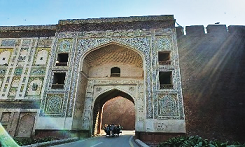
|
|
Shalamar Garden
|
Shalamar Town Lahore
|
1642
|
Mughal Emperor Shah Jahan
|
World Heritage Site UNESCO
|
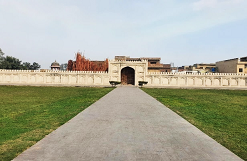
|
|
Badshahi Mosque
|
Walled city Lahore
|
1673
|
Mughal Emperor Aurangzeb Alamgir
|
Tentative World Heritage UNESCO
|

|
|
Wazir Khan Mosque
|
Walled city Lahore
|
1641
|
Mughal Emperor Shah Jahan
|
Tentative World Heritage UNESCO
|

|
|
Sheesh Mahal
|
Walled city Lahore
|
1632
|
Mughal Emperor Shah Jahan
|
Antiquities Act, 1975 DOAM, Pakistan
|
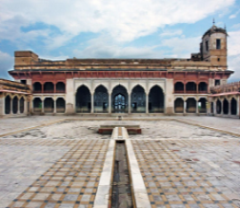
|
|
Lahore Museum
|
Mall Road Lahore
|
1865
|
British Colonial Period
|
Special Premises, 1985 DOAM, Pakistan
|

|
|
NCA Lahore
|
Mall Road Lahore
|
1875
|
British Colonial Period
|
Special Premises, 1985 DOAM, Pakistan
|
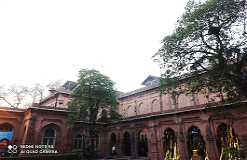
|
|
UET Lahore
|
G. T. Road Lahore
|
1921
|
British Colonial Period
|
Oldest Engineering
Institute
|
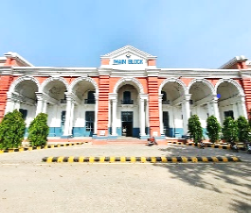
|
|
GCU Lahore
|
Katchery Road, Lahore
|
1864
|
British Colonial Period
|
Special Premises, 1985 DOAM, Pakistan
|
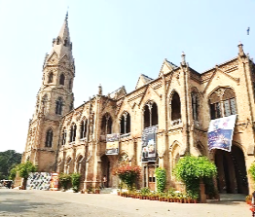
|
|
GDSC Lahore
|
Nisbat Road, Lahore
|
1910
|
British Colonial Period
|
Special Premises, 1985 DOAM, Pakistan
|
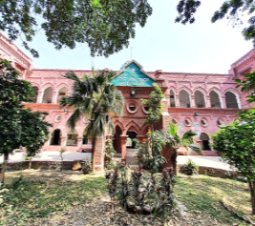
|
|
UVAS Lahore
|
Syed Abdul Qadir Jillani Road, Lahore
|
1882
|
British Colonial Period
|
Special Premises, 1985 DOAM, Pakistan
|

|
|
PUCIT Lahore
|
Mall Road, Lahore
|
1882
|
British Colonial Period
|
Special Premises, 1985 DOAM, Pakistan
|
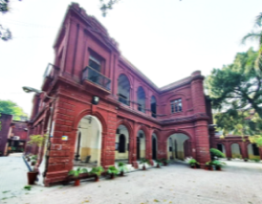
|
Note. Sources (Taimoor, 2022)
Figure 1
Methodology Flowchart
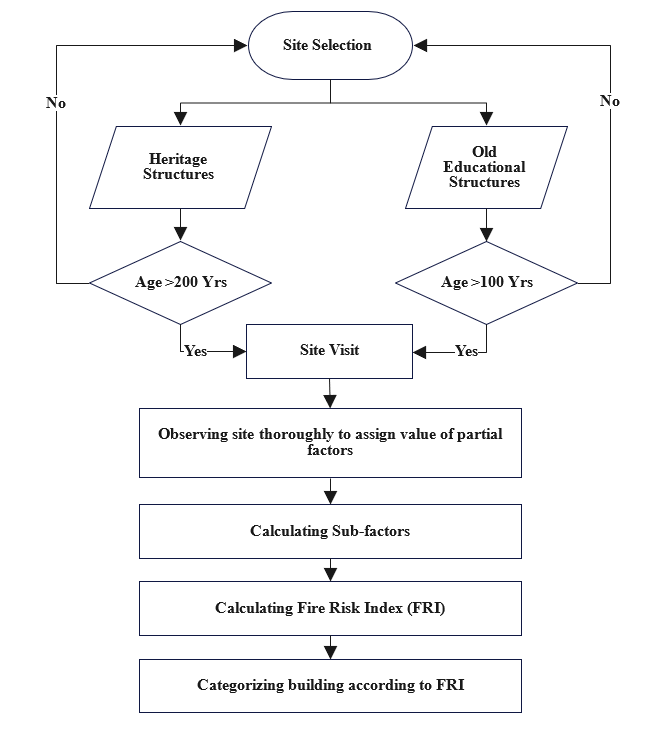
Fire Risk Index (FRI) Method
In this study, the FRI method was adopted to carry out the fire risk assessment. This method was created and applied by Ferreira for fire risk assessment in the historical city of Guimaraes, Portugal (Granda & Ferreira, 2021). FRI has two main factors, namely Global Risk Factor (GRF) and Global Efficiency Factor (GEF). The global factors are divided into sub-factors in such a way that GRF is composed of the main sub-factors ignition of fire (I), propagation of fire (P), and evacuation of occupants (E). Whereas, GEF has only one sub-factor of fire combat (C). These main sub-factors are further divided into a series of 15 different partial sub-factors. The factors considered in this method are in accordance with the Portuguese fire safety code. The definitions of global factors, main sub-factors, and partial sub-factors are given in Table 2.
Table 2
Definition of Global Factors, Main Sub-factors, and Partial Sub-factors
|
Global Factors
|
Main Sub-factors
|
Partial Sub-factors
|
|
Global Risk Factor (GRF)
|
Ignition of fire (I)
|
Building conservation state (I1)
|
|
Electric installations (I2)
|
|
Gas installations (I3)
|
|
Fire load nature (I4)
|
|
Propagation of fire (P)
|
Gap between aligned openings (P1)
|
|
Safety and security teams (P2)
|
|
Fire detection, alert and alarm (P3)
|
|
Fire compartmentalization (P4)
|
|
Fire loads (P5)
|
|
Evacuation of occupants (E)
|
Evacuation and escape routes (E1)
|
|
Building properties (E2)
|
|
Evacuation correction factors (E3)
|
|
Global Efficiency Factor (GEF)
|
Fire combat (C)
|
Building external fire combat factors (C1)
|
|
Building internal fire combat factors (C2)
|
|
Security teams (C3)
|
The weighted average of the aforementioned sub-factors divided by the Reference Risk Factor (RRF) yields the FRI value, as shown by Eq. (1) below. The values of 1.20 and 1.10 are used with the ignition of fire (I) and the propagation of fire (P) sub-factors respectively, since they play an important role during the process of fire risk. (1)
Reference Risk Factor
The value of Reference Risk Factor (RRF) depends upon the type of building. A correction factor Fc was included to determine RFF which can have a value of 1.10, 1.20, or 1.30, corresponding to building floors 3, 7, or more than 7, respectively (Ouache, 2021). The determination of RRF is shown in Table 3.
Table 3
Determination of Reference Risk Factor (RRF)
|
Building Type
|
Reference Risk Factor (RRF)
|
|
Residential
|
|
|
Industrial places, archives, and libraries
|
|
Ignition of Fire Sub-factor (I)
The sub-factor ignition of fire has four partial sub-factors, namely building conservation state (I1), electric installations (I2), gas installations (I3), and fire load nature (I4). The building conservation state (I1) determines the state of conservation of different elements present in the structure. The partial sub-factor of electric installations (I2) is related to the maintenance conditions of electric circuits present in the buildings. Gas installations (I3) are linked with the location of gas supply in structures and the availability of the ventilation system. The fire load nature (I4) depends upon the combustibility of structural materials. The values for conditions of gas installations (I3) are shown in Table 4.
Table 4
Values for Conditions of Gas Installations (I3)
|
Supply Type
|
Installation
|
Compartment Ventilation
|
Partial Factor (I3) Value
|
|
Piped
|
|
|
1.00
|
|
Reservoir
|
|
|
1.10
|
|
Containers
|
External
|
|
1.20
|
|
|
Internal
|
Well-ventilated
|
1.50
|
|
|
|
Non-ventilated
|
1.80
|
Propagation of Fire Sub-factor (P)
There are five partial sub-factors included in the sub-factor of the propagation of fire (P), namely the gap between aligned openings (P1), safety and security teams (P2), fire detection, alert and alarm (P3), fire compartmentalization (P4), and fire loads (P5). Partial sub-factor P1 includes the number of gaps present between the openings at a distance of less than 1.10 m (Julià & Ferreira, 2021). P2 depends upon the presence of security teams in the structures. P3 is related to the presence of fire detection system in the structures. There are two kinds of fire detection systems including the manual fire detection system and the automatic fire detection system. The values for the conditions of partial sub-factor P3 are shown in Table 5. P4 deals with the resistance to fire of structural elements. Finally, P5 determines the amount of the load of fire present in the structure.
Table 5
Values for Conditions of Fire Detection, Alert, and Alarm System (P3)
|
System Requirement
|
System Present
|
Partial Factor (P3) Value
|
|
Not required
|
Automatic fire detection system
|
0.50
|
|
Manual fire detection system
|
0.90
|
|
Manual fire detection system
|
Manual fire detection system
|
1.00
|
|
No fire detection system
|
1.20
|
|
Automatic fire detection system
|
Manual fire detection system
|
1.80
|
|
No fire detection system
|
2.00
|
Evacuation of Occupants Sub-factor (E)
The sub-factor evacuation of occupants (E) has three partial sub-factors, namely evacuation and escape routes (E1), building properties (E2), and evacuation correction factors (E3). E1 is linked with the conditions of evacuation from the structure. The opening widths of doors and windows, the number of exits, escape route slopes, and existence of emergency systems of light signaling are considered in determining the partial sub-factor E1. The values for the conditions of E1 are shown in Table 6. E2 depends upon the alert of fire, security team existence, and evacuation frequency. E3 is considered in case the other partial sub-factors of the sub-factor (E) are not applied correctly (Ferreira & Eudave, 2022).
Table 6
Values for Conditions of Evacuation and Escape Routes (E1)
|
Conditions
|
Partial Factor (E1) Value
|
|
Opening widths lower than 0.9 m
|
0.25
|
|
Number of exits lower than minimum required
|
0.25
|
|
Escape route slope higher than 45°
|
0.25
|
|
Absence of emergency systems of light signaling
|
0.25
|
Fire Combat Sub-factor (C)
There are three partial sub-factors included in the fire combat sub-factor (C), namely building external fire combat factors (C1), building internal fire combat factors (C2), and security teams (C3). C1 is dependent on external fire hydrants, accessibility parameters, and the consistency of water supply. Route width, slope, building height, and route clear height are all related to the accessibility parameter. The values for the conditions of the accessibility parameter are shown in Table 7. The external fire hydrants parameter is related to the presence of fire hydrants in the structure (Ferreira et al., 2016). Table 8 shows the values for the conditions of the parameters of external fire hydrants.
Table 7
Values for Conditions of Accessibility Parameter
|
Building Height (m)
|
Route Width (m)
|
Route Clear Height (m)
|
Route Slope (%)
|
Accessibility Parameter Value
|
|
≤ 9.00
|
≥ 3.50
|
≥ 4.00
|
≤ 15.00
|
1.00
|
|
≥ 3.50
|
≥ 4.00
|
> 15.00
|
1.50
|
|
> 9.00
|
≥ 6.00
|
≥ 5.00
|
≤ 10.00
|
1.00
|
|
≥ 6.00
|
≥ 5.00
|
> 10.00
|
1.50
|
Table 8
Values for Conditions of External Fire Hydrants Parameter
|
Distance from Fire Hydrant (m)
|
Wall Hydrants Presence
|
Fire Hydrants Parameter Value
|
|
≤ 100
|
No
|
1.00
|
|
> 100
|
Yes
|
1.50
|
|
No
|
2.00
|
Fire Risk Classification
Fire risk classification system was adopted in this research. The FRI value was used to classify the structure into three categories, that is, low-risk buildings, moderate-risk buildings, and high-risk buildings. The fire classification system was used to further sub-divide these three categories, providing better understanding of structures with respect to fire risk safety (Ferreira et al., 2016). The classification system for fire risk is shown in Table 9.
Table 9
Classification System for Fire Risk
|
Category
|
Fire Risk Classification System
|
Fire Risk Index Value (FRI)
|
|
Low-risk buildings
|
Very low (A++)
|
FRI < 0.90
|
|
Low (A+)
|
0.90 < FRI ≤ 0.95
|
|
Acceptable (A)
|
0.95 < FRI ≤ 1.00
|
|
Small+ (B+)
|
1.00 < FRI ≤ 1.05
|
|
Low-risk buildings
|
Small (B)
|
1.05 < FRI ≤ 1.10
|
|
Small- (B-)
|
1.10 < FRI ≤ 1.15
|
|
Moderate-risk buildings
|
Medium+ (C+)
|
1.15 < FRI ≤ 1.20
|
|
Medium (C)
|
1.20 < FRI ≤ 1.25
|
|
Medium- (C-)
|
1.25 < FRI ≤ 1.30
|
|
Category
|
Fire Risk Classification System
|
Fire Risk Index Value (FRI)
|
|
High-risk buildings
|
Elevated (D)
|
1.30 < FRI ≤ 1.50
|
|
Very Elevated (E)
|
1.55 < FRI ≤ 1.70
|
|
Imminent (F)
|
FRI > 1.70
|
Results and Discussion
Fire Risk Index (FRI) Values
The FRI values of the heritage structures included in this study were calculated. The highest FRI value was found to be of Sheesh Mahal, whereas the lowest FRI value was found to be of Badshahi Mosque. A high FRI value shows that there are relatively more chances of fire in the structure as compared to the one with a relatively low FRI value. The sub-factors ignition of fire (I) and propagation of fire (P) are the critical sub-factors in case of Sheesh Mahal’s FRI value. The presence of a wooden roof system, high voltage wiring, open electric circuits, and fire susceptible structural material in Sheesh Mahal contribute towards making it the most fire susceptible heritage structure. The covering of electric wires with PVC casting, absence of gas stations, and availability of a large evacuation area make Badshahi Mosque the least fire susceptible heritage structure among the heritage structures included in this study (Khan & Hamid, 2017). Fig. 2 shows FRI values of the heritage structures included in the study.
Figure 2
FRI Values of Heritage Structures
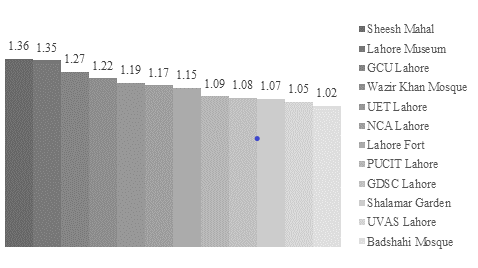
Fire Risk Classification
The fire risk classification system was used to further sub divide the heritage structures on the basis of their FRI values, as shown in Table 10. Hence, the heritage structures were categorized into low-risk buildings, moderate-risk buildings, and high-risk buildings. The classification of heritage structures according to their FRI values was found to be beneficial in the decision-making process regarding which heritage structure required relatively more fire safety measures as compared to others. In this regard, Sheesh Mahal and Lahore Museum were categorized to be high-risk buildings according to their FRI values. However, Wazir Khan Mosque, NCA Lahore, UET Lahore, and GCU Lahore were categorized as moderate-risk buildings. Lastly, the FRI values of Lahore Fort, Badshahi Mosque, Shalamar Garden, GDSC Lahore, UVAS Lahore, and PUCIT Lahore allowed them to be categorized as low-risk buildings (Chishti et al., 2017). It was found that among the heritage structures included in the study 17% were high-risk buildings, 33% were moderate-risk buildings, and 50% were low-risk buildings, as shown in Fig. 3. Figure 4 shows the map which depicts the location, FRI values, and classification of selected heritage structures.
Table 10
Fire Risk Classification of Heritage Structures
|
Heritage Structure
|
Fire Risk Index value (FRI)
|
Category
|
Fire Risk Classification
|
|
Sheesh Mahal
|
1.36
|
High-Risk Building
|
Elevated
|
D
|
|
Lahore Museum
|
1.35
|
High-Risk Building
|
Elevated
|
D
|
|
GCU Lahore
|
1.27
|
Moderate-Risk Building
|
Medium
|
C-
|
|
Wazir Khan Mosque
|
1.22
|
Moderate-Risk Building
|
Medium
|
C
|
|
UET Lahore
|
1.19
|
Moderate-Risk Building
|
Medium+
|
C+
|
|
NCA Lahore
|
1.17
|
Moderate-Risk Building
|
Medium+
|
C+
|
|
Lahore Fort
|
1.15
|
Low-Risk Building
|
Small-
|
B-
|
|
PUCIT Lahore
|
1.09
|
Low-Risk Building
|
Small
|
B
|
|
GDSC Lahore
|
1.08
|
Low-Risk Building
|
Small
|
B
|
|
Shalamar Garden
|
1.07
|
Low-Risk Building
|
Small
|
B
|
|
UVAS Lahore
|
1.05
|
Low-Risk Building
|
Small+
|
B+
|
|
Badshahi Mosque
|
1.02
|
Low-Risk Building
|
Small+
|
B+
|
Figure 3
Percentage of Fire Risk Classified Heritage Structures
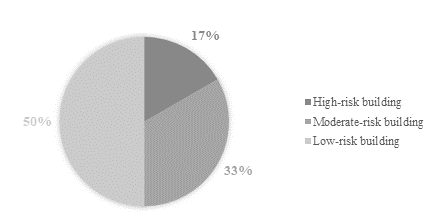
Figure 4
Mapping of FRI values and Classification of Heritage Structures
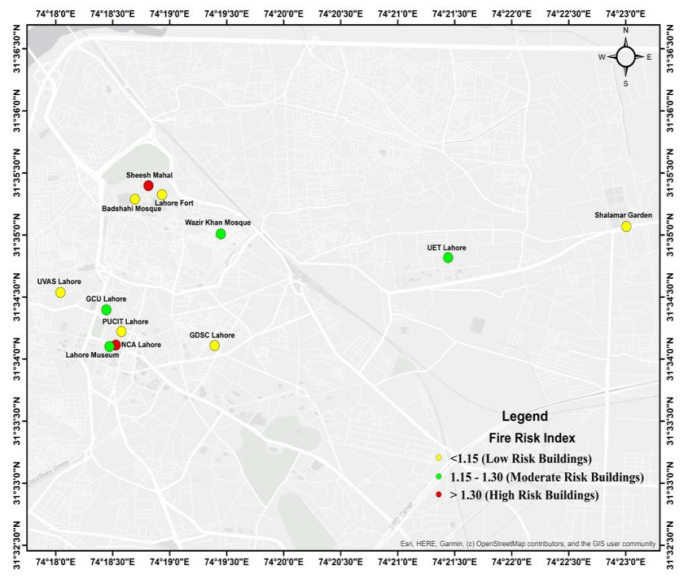
Building spotted as red are high-risk buildings (FRI values greater than 1.30), yellow spots represent moderate-risk buildings (FRI value 1.15-1.30), and green spots represent low-risk buildings (FRI values smaller than 1.15).
Sub-factors Contribution
The presence of wooden structural material, open electric circuits, narrow escape routes, and unavailability of fire safety equipment were the key factors that contributed towards raising the FRI values of heritage structures. Sheesh Mahal and Lahore Museum were the heritage structures classified as high-risk buildings in this study. The presence of a wooden roof system in Sheesh Mahal as well as the presence of wooden showcases and artefacts in Lahore Museum were the reasons for their relatively higher FRI values as compared to other structures included in the study. The contributing factors of fire in high-risk buildings is shown in Fig. 5.
Figure 5
Contributing Factors of Fire in High-Risk Buildings: (A) Wooden Roof System in Sheesh Mahal (B) Wooden Showcases and Artefacts in Lahore Museum
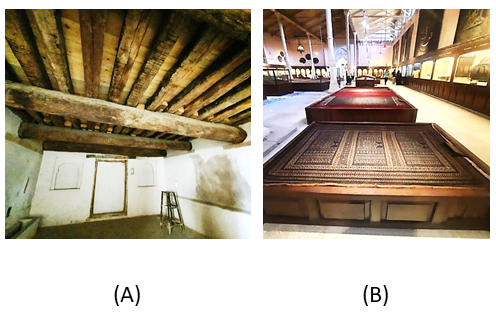
The evaluation of the FRI values of sub-factors was crucial as it allowed to determine the probable cause of fire in any specific heritage structure. The values for the sub-factors of heritage structures included in the study are shown in Table 11.
Table 11
Values for Sub-Factors of Heritage Structures
|
Heritage Structure
|
Ignition of Fire (I)
|
Propagation of Fire (P)
|
Evacuation of Occupants (E)
|
Fire Combat (C)
|
|
Sheesh Mahal
|
2.04
|
1.94
|
1.32
|
1.61
|
|
Lahore Museum
|
1.96
|
2.25
|
1.41
|
1.19
|
|
GCU Lahore
|
1.41
|
2.45
|
1.33
|
1.25
|
|
Wazir Khan Mosque
|
1.23
|
2.04
|
1.32
|
1.67
|
|
UET Lahore
|
0.92
|
1.84
|
1.42
|
1.61
|
|
NCA Lahore
|
1.39
|
1.75
|
1.41
|
1.42
|
|
Lahore fort
|
0.86
|
1.81
|
1.45
|
1.57
|
|
PUCIT Lahore
|
1.06
|
1.64
|
1.48
|
1.44
|
|
GDSC Lahore
|
0.79
|
1.47
|
1.40
|
1.50
|
|
Shalamar Garden
|
1.21
|
1.54
|
1.22
|
1.50
|
|
UVAS Lahore
|
1.25
|
1.44
|
1.23
|
1.47
|
|
Badshahi Mosque
|
1.08
|
1.34
|
1.28
|
1.58
|
In this study, it was observed that the ignition of fire (I) sub-factor was prominent in 8% heritage structures, fire combat (C) sub-factor was prominent in 25% heritage structures, and propagation of fire (P) sub-factor was prominent in 67% heritage structures. Fig. 6 shows the percentage of sub-factors which were prominent in heritage structures included in the study. The propagation of fire (P) sub-factor is linked with the tendency of structures to spread fire. The results showed that 67% heritage structures can catch fire due to the excessive presence of wooden elements in them. The fire combat (C) sub-factor is related to the availability of fire safety equipment in heritage structures. The results showed that 25% heritage structures can catch fire due to the unavailability of proper fire safety equipment. The ignition of fire sub-factor (I) is related with the ability of the structure to spark fire. The results showed that 8% heritage structures can spark fire due to the presence of open electric circuits (Khan & Afzaal, 2021).
Figure 6
Percentage of Sub-Factors Prominent in the Heritage Structures Included in Study
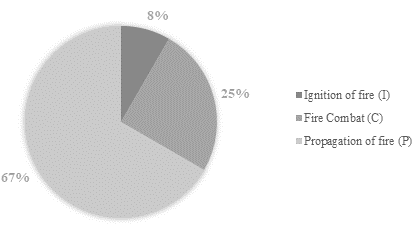
Figure 7
Sub-Factor Values of Heritage Structures: (A) Ignition of Fire; (B) Propagation of Fire; (C) Evacuation of Occupants; (D) Fire Combat
(A)
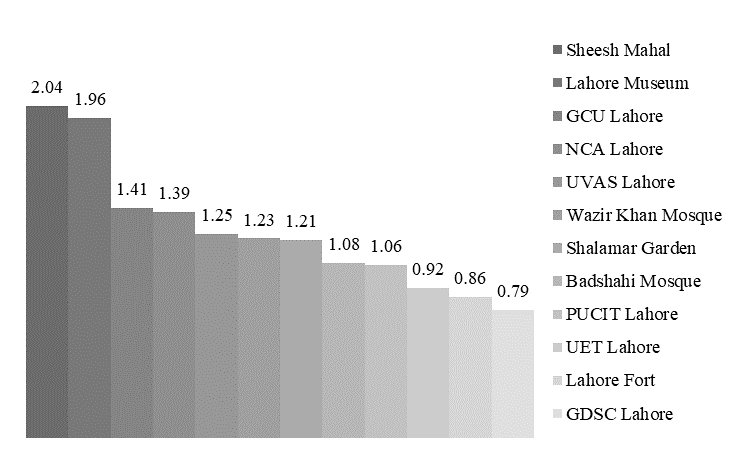
(B)

(C)

(D)
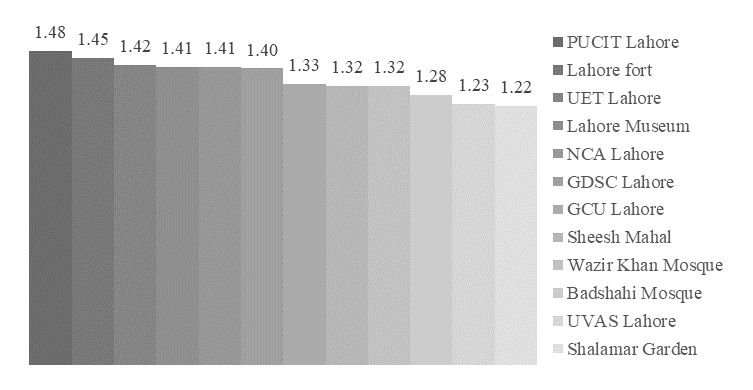
The highest value for the ignition of fire (I) sub-factor of 2.04 was calculated for Sheesh Mahal, whereas the lowest value for the ignition of fire (I) sub-factor of 0.79 was calculated for GDSC, Lahore. The wooden roof system in Sheesh Mahal was the reason for its relatively higher value of fire ignition (I) sub-factor. The highest value for the propagation of fire (P) sub-factor of 2.45 was calculated for GCU Lahore, whereas the lowest value for the propagation of fire (P) sub-factor of 1.34 was calculated for Badshahi Mosque. The doors and windows of GCU Lahore are made of wood which was the reason of its relatively higher value of fire propagation (P) sub-factor. The fire resistance of Sheesh Mahal and GCU Lahore can be improved by fire proofing of built elements present in them. The highest value for the evacuation of occupants (E) sub-factor of 1.48 was calculated for PUCIT Lahore, whereas the lowest value for the evacuation of occupants (E) sub-factor of 1.22 was calculated for Shalamar Garden. It was found that the number of evacuation routes in PUCIT Lahore are minimal among all heritage structures included in the study. The chances of fire in PUCIT Lahore can be reduced by increasing the number of evacuations routes. The highest value for the fire combat (C) sub-factor of 1.67 was calculated for Wazir Khan Mosque, whereas the lowest value for the fire combat (C) sub-factor of 1.19 was calculated for Lahore Museum. The results showed that the availability of fire safety equipment in Wazir Khan Mosque is minimal among all heritage structures included in the study. The fire risk of Wazir Khan Mosque can be reduced by providing access to adequate fire safety equipment. Fig. 7 shows the sub-factor values of heritage structures included in the study.
Conclusion
The fire risk assessment of 12 heritage structures located in Lahore was carried out by using FRI method. The FRI values and contributing sub-factors were evaluated according to Portuguese fire safety code. The heritage structures included in this study were classified on the basis of their FRI values. The highest FRI value of 1.36 was observed in Sheesh Mahal whereas the lowest FRI value of 1.02 was observed in Badshahi Mosque. There were 17% high-risk buildings, 33% moderate-risk buildings, and 50% low-risk buildings out of the heritage structures included in study. The heritage structures included in study have 8% heritage structures in which ignition of fire sub-factor (I) is prominent, 25% heritage structures in which fire combat sub-factor (C) is prominent, and 67% heritage structures in which propagation of fire sub-factor (P) is prominent. The highest values for ignition of fire sub-factor (I), propagation of fire sub-factor (P), evacuation of occupants sub-factor (E), and fire combat sub-factor (C) were found in Sheesh Mahal, GCU Lahore, PUCIT Lahore, and Wazir Khan Mosque respectively. The fire proofing of wooden elements, availability of fire safety equipment, renovation of electric circuits, and increasing the number of evacuation routes were the key findings which can enhance the resistance to fire of the heritage structures included in study.
It is a matter of concern that Pakistan has not developed any fire risk assessment technique to evaluate fire risk in heritage structures. Fire mitigation strategies should be applied on Sheesh Mahal and Lahore Museum on a priority basis, since this study makes it evident that these structures have a high fire risk. Among historic educational institutions, GCU Lahore should be dealt with first since it is severly prone to fire risk.
Future Directions
Future research should concentrate on creating a method for assessing fire risk, keeping in view the local conditions of Pakistan with respect to construction materials, culture, and the environment. A structured approach should be proposed to mitigate fire risks, involving a range of intervention packages for different levels of risk reduction. After each intervention, the fire risk index should be recalculated and if the building falls within the safe limit, the process may conclude. If not, subsequent intervention packages should be applied until the building acquires a safe FRI value. Moreover, fire risk assessment of other structures including commercial buildings, shopping plazas, hospitals, and hotels should also be addressed in future studies.
References
Chishti, R., Seemi, I., & Mujeeb, Z. H. (2017). The Shalamar Gardens Lahore: A case study of Mughal Garden design and concept. Putaj Humanities & Social Sciences, 24(2), 100–107.
Danzi, E., Fiorentini, L., & Marmo, L. (2021). FLAME: A parametric fire risk assessment method supporting performance based approaches. Fire Technology, 57, 721–765. https://doi.org/10.1007/s10694-020-01014-9
Ferreira, T. M., & Eudave, R. R. (2022). Assessing and managing risk in historic Urban Areas: Current trends and future research directions. Frontiers in Earth Science, 10, Article e847959. https://doi.org/10.3389
Ferreira, T. M., Vicente, R., da Silva, J. A. R. M., Varum, H., Costa, A., & Maio, R. (2016). Urban fire risk: Evaluation and emergency planning. Journal of Cultural Heritage, 20, 739–745. https://doi.org/10.1016/j.culher.2016.01.011
Garcia-Castillo, E., Paya-Zaforteza, I., & Hospitaler, A. (2022). Fire in heritage and historic buildings, a major challenge for the 21st century. Developments in the Built Environment, 13, Article e100102. https://doi.org/10.1016/j.dibe.2022.100102
Garcia-Castillo, E., Paya-Zaforteza, I., & Hospitaler, A. (2023). Fire in heritage and historic buildings, a major challenge for the 21st century. Developments in the Built Environment, 13, Article e100102. https://doi.org/10.1016/j.dibe.2022.100102
Government of Pakistan. (2016). Building code of Pakistan: Fire safety provisions. https://www.studocu.com/row/document/university-of-sindh/women-peace-building/building-safety-code-of-pakitan/9404877
Granda, S., & Ferreira, T. M. (2019). Assessing vulnerability and fire risk in old urban areas: Application to the historical centre of Guimarães. Fire Technology, 55(1), 105–127. https://doi.org/10.1007/s10694-018-0778-z
Granda, S., & Ferreira, T. M. (2021). Large-scale vulnerability and fire risk assessment of the historic centre of Quito, Ecuador. International Journal of Architectural Heritage, 15(7), 1043–1057. https://doi.org/10.1080/15583058.2019.1665142
Iftikhar, R. (2019). Lahore Fort-a Mughal monument on the verge of decline. Journal of the Research Society of Pakistan, 56(1), 27–40.
Julià, P. B., & Ferreira, T. M. (2021). From single-to multi-hazard vulnerability and risk in Historic Urban Areas: A literature review. Natural Hazards, 108(1), 93–128. https://doi.org/10.1007/s11069-021-04734-5
Juliá, P. B., Ferreira, T. M., & Rodrigues, H. (2021). Post-earthquake fire risk assessment of historic urban areas: A scenario-based analysis applied to the Historic City Centre of Leiria, Portugal. International Journal of Disaster Risk Reduction, 60, Article e102287. https://doi.org/10.1016/j.ijdrr.2021.102287
Khan, H. A., & Afzaal, K. (2021). Representing religious identity: Lahore Museum, 1960s-1990s. Pakistan Vision, 22(2), 29–42.
Khan, M. M., & Hamid, S. (2017). Standing Buddha sculptures in stone from the collection of Lahore Museum: Study and analysis. Pakistan Heritage, 9, 11–22.
Neto, J. T., & Ferreira, T. M. (2020). Assessing and mitigating vulnerability and fire risk in historic centres: A cost-benefit analysis. Journal of Cultural Heritage, 45, 279–290. https://doi.org/10.1016/j.culher.2020.04.003
Ouache, R. (2021). An integrated fire risk management of multi-unit residential buildings with smart and green features: machine learning-based framework [Doctoral dissertation, University of British Columbia]. The University of British Columbia Liberary. https://dx.doi.org/10.14288/1.0397210
Rafi, M. M., Wasiuddin, S., & Siddiqui, S. H. (2012). Assessment of fire hazard in Pakistan. Disaster Prevention and Management, 21(1), 71–84. https://doi.org/10.1108/09653561211202719
Santos, C. C., Correia, J., Correia, A., Meneses, S., & Tavares, P. (2017, June 7–9). Fire risk assessment in old urban areas: Coimbra old town(Paper presentation). 2nd International Fire Safety Symposium. Naples, Italy. http://hdl.handle.net/10400.11/6499
Santos, C., Ferreira, T. M., Vicente, R., & da Silva, J. R. M. (2013). Building typologies identification to support risk mitigation at the urban scale–Case study of the old city centre of Seixal, Portugal. Journal of Cultural Heritage, 14(6), 449–463. https://doi.org/10.1016/j.culher.2012.11.001
Shahid, S. H., Maqbool, S., & Haseeb, S. (2014). Structural fire safety measures in developing countries: Pakistan-a case study. International Journal of Engineering and Advanced Technology, 4(1), 95–101.
Shan, M., Chen, Y. F., Zhai, Z., & Du, J. (2022). Investigating the critical issues in the conservation of heritage building: The case of China. Journal of Building Engineering, 51, Article e104319. https://doi.org/10.1016/j.jobe.2022.104319
Taimoor, N. (2022, March 25). 10 best historical places in Lahore. https://www.graana.com/blog/historical-places-in-lahore/
The Express Tribune. (2016, June 23). Fire erupts at 500-year-old Sheesh Mahal. https://tribune.com.pk/story/1128979/flames-fire-erupts-500-year-old-sheesh-mahal
The Express Tribune. (2023, May 16). Radio Pakistan attack: Rare handwritten scripts, music records burnt to ashes. https://tribune.com.pk/story/2417082/radio-pakistan-attack-rare-handwritten-scripts-music-records-burnt-to-ashes
The Government of Punjab. (n.d.). Architectural heritage. (n.d.). Retrieved January 11, 2024, from https://www.punjab.gov.pk/lahore_architectural_heritage
Venegas, D., Erazo, O., Farías, Ó., Ayabaca, C., & Medina, A. (2020, October 19–23). Fires in world heritage buildings (Paper presentation). Proceedings of Artificial Intelligence, Computer and Software Engineering Advances. Quito, Ecuador. https://doi.org/10.1007/978-3-030-68080-0_32